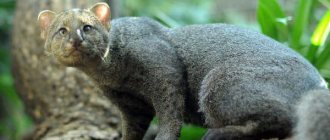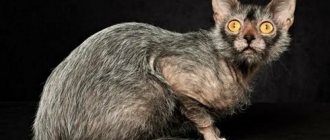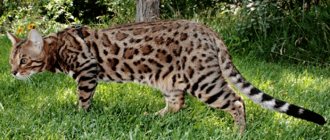The jungle cat (house) is a magnificent representative of the cat family, known to most of the world's population as the swamp lynx. Nowadays it is an expensive and rare pet for exotic lovers.
The graceful predator has become a sought-after animal for home breeding. The jungle cat combines the best features of a predatory and domestic representative of the family.
History of the species
The history of jungle cats begins when the ancient Egyptians domesticated a subspecies of the cat called Felis chaus. This is a type of African cat, the image of which is preserved on many famous figurines from the times of Ancient Egypt.
The ancient Egyptians domesticated African cats from nearby territories.
These were excellent hunters who brought prey to their masters and replaced dogs as guards. Beginning in the 18th century, attempts began to crossbreed the jungle cat with other representatives of cat breeds in order to breed a pet that could retain a developed hunting instinct combined with an amiable character.
IMPORTANT: Wikipedia indicates that the “reed cat” species was first described by the imperial naturalist Johann Anton Güldenstedt in 1776.
Currently, the wild reed cat lives in more than 20 countries around the world, and the largest representatives of the subspecies have settled in the Caucasus. Reed cats or “swamp lynxes” prefer to live next to people, which often causes discontent among the latter: the wild habits of these animals can deprive the farm of a significant number of small livestock.
The jungle cat, although not ferocious, is still a wild and unpredictable beast
IMPORTANT: the jungle cat is listed in the Red Book of Russia and is protected by law.
The jungle cat is used in breeding, bringing into the world exotic offspring. One of these original breeds is the Chausie - a mixture of the jungle and Abyssinian cat, which was bred and officially registered in 1995.
The photo shows a representative of the Chausie breed
In its pure form, the total number of representatives of the subspecies falls annually, which is associated with continuous deforestation and the death of animals in forest fires, which often burn in the steppe regions of their habitat.
Hausie coat color and texture
Wool changes its structure significantly depending on the season. In summer it becomes tougher and looser. By winter, chausies become pubescent. The coat becomes thicker and softer. The undercoat becomes denser.
Read here Abyssinian cat - character, description of the breed, diseases and maintenance features (90 photos)
The color completely matches the color of wild relatives. It can fluctuate a bit, but generally has sandy gray undertones.
Chausies may have a tendency to have a monochromatic coat, or exhibit spotting in the form of black spots and sometimes even stripes.
Appearance and features
At first glance, the jungle cat is not much different from an ordinary pet, but this is a misconception. The appearance and character of animals have differences that are most clearly determined by the description of the breed.
Cats of this subspecies have many similarities with other felines.
Dimensions and weight of jungle cats
The size and weight of the animal indicate that the jungle cat is somewhat larger than domestic felines. The body length of a jungle cat can reach 50-95 cm, and its weight does not exceed 15 kg.
Anatomical features
This subspecies of felines has a very developed body structure, especially the muscles that are always in good shape, as well as strong and long paws, thanks to which the animal moves deftly across any terrain. They move quickly and gracefully across the surface, jump high and skillfully climb trees.
This type of cat has pronounced yellow or green eyes.
The animal's tail has a black tip, but is not particularly long or thick. The ears are decorated with graceful tassels, and their height, in some cases, can reach eight centimeters.
Color
The animal's coat is short, with a thick undercoat, which has the unique natural property of quickly removing dirt and strong water-repellent ability. In summer, jungle cats “dress up” with shorter fur, and in winter their coats become fluffier. Often the color of the animal is a gray-red camouflage.
The color of the jungle cat helps it camouflage and hunt in natural conditions
Cat Chausie
There is a special, new breed, bred by crossing a wild reed breed (males only) with a regular cat - Chausie (Chausie). Externally, the pet is very similar to its father, but there are differences:
- the tips of the ears and tail are strictly black:
- smaller dimensions, weight;
- elongated tail.
It is more difficult to train such a cat to use a litter box, but its character is more flexible; with proper training, they become excellent companions. The parent’s genes make themselves felt with similar signs:
- love of open spaces;
- sociability;
- passion for bathing;
- large dimensions.
The distinctive features of the domestic version of the reed breed are reflected in physiological signs:
- hybrids have sensitive stomachs, it is strictly forbidden to feed your pets pork and grains;
- sterility of males until the third generation.
Features of character and lifestyle
The jungle cat is a wild predator whose habitat has taught it to live and survive in harsh natural conditions. The character of the animal is also formed here, which is inherited by its direct descendants by genotype.
Determination, pride and intelligence, heightened by the survival instinct - all this forms the basis of the jungle cat’s character. Such a pet will not put up with an encroachment on his personal space and will not obediently tolerate an attitude that seems unacceptable to him. The wild nature has forever programmed in these animals a pronounced desire for independence. The jungle cat will defend itself and its territory to the last.
Jungle cats are especially fierce in protecting their offspring.
IMPORTANT: jungle cats can act very domestically; in particular, they meow and purr in exactly the same way as regular domestic cats.
One of the most pronounced traits in the character of the jungle cat is a love of solitude and a nocturnal lifestyle, which is why the cat sleeps a lot during the day and is awake at night. For rest, the animal chooses a warm and safe place for itself, since it does not perceive cold well and is not at all adapted to sub-zero temperatures. Most of the time, jungle cats lurk in dense thickets, where they hide from stronger competitors (wolves, large dogs and leopards).
With the onset of darkness, they go out hunting, skillfully pursue prey in long runs and deft silent attacks, are not afraid of water, are excellent at catching fish and generally have extraordinary hunting skills.
Is it possible to keep a jungle cat at home?
At first glance, it may seem that such an idea is nonsense and it is impossible to train a wild animal. This is partly true, but still cases of keeping a jungle cat at home exist and are successfully practiced with one condition: the future pet must get used to living together with a person from the first months of life. Otherwise, the training enterprise is doomed to failure and it will be almost impossible to curb the wild nature of the animal.
The jungle cat can become a pet and an exotic decoration for the home, but this will require a lot of time and effort.
Many people, in pursuit of the exotic, forget that some breeds are bred and evolved directly for domestic conditions, but not all types of cats are able to adapt to life in captivity. The jungle cat is one of those closest relatives of cats that was created by nature for a wild habitat. He cautiously and warily welcomes human society, and will perceive any attempts to limit freedom as a threat to his own safety. It is for this reason that jungle cats are purchased as one-month-old kittens, subject to patient and long-term care for the animal. Only in this case is there a real chance of raising a pet that will peacefully and obediently coexist next to a person.
IMPORTANT: we should not forget that surrounded by human care and the best living conditions, the jungle cat forever remains a wild predator.
Choosing a kitten
Finding a real jungle kitten is not an easy task. They are bred only in nurseries, of which there are very few. You can also try to buy a kitten at an exhibition of elite breeds. If you finally make up your mind and find a kitten, ask the breeders to show its parents . You must make sure that they are indeed real jungle cats.
The type of pedigree papers that must accompany the kitten will only mean something to you and a certain circle of people who are involved in Houses. This is because the breed is considered wild and is not recognized by any of the clubs and federations. The price of a baby jungle cat is “biting”. It starts at five thousand dollars, but according to other sources, the bill goes into tens of thousands for a real Hausa.
Look carefully at the kitten, it should be active and playful. The coat and eyes should look good. Mother and kittens must be well-groomed. By the time you decide to take the baby, he should be treated with helminths and given the necessary vaccinations. As a rule, this is done before three months of age. We must remember that this is a wild animal. You can win over the baby by picking him up as early as possible.
Did you know? Jungle cat kittens are born with stripes that disappear with the onset of puberty: natural camouflage for the period until the animals can fend for themselves.
Features of care
The jungle cat is by no means hardened by a “sofa” lifestyle, therefore it has excellent health and physical indicators that are the envy of all domestic cats. The nuances of the conditions of detention include several points:
- Rabies vaccinations are at the top of the list of jungle cat care obligations;
- Walking in the fresh air is an obligatory part of the animal’s lifestyle; the jungle cat gets used to a leash and harness without much persuasion;
The jungle cat needs frequent walks and exercise.
- Keeping such a cat in a cramped environment is a very bad idea: the animal needs space with a variety of games and entertainment;
- It is important to support your pet’s hunting instinct so that it does not get bored and does not begin to show unreasonable aggression: sometimes you can buy a live mouse or fish at a pet store, which the cat will happily hunt;
- Mixed breeds of this type are kept in comfortable enclosures equipped for natural conditions;
- Bathing for such an animal is a true pleasure, so it is advisable to open the swimming season for it at least once every two months;
Jungle cats love to swim and hunt in water
- At home, jungle cats are prone to weight gain; for this reason, the pet’s diet should be strictly controlled;
- It is necessary to comb out the jungle cat during the seasonal molting period; a furminator copes best with this task;
Breed Features
The jungle cat is by nature a wild animal . Maintaining, raising and caring for him at home is quite difficult. He is very different from domestic cats, not only in appearance, but also in character.
Important! The Hausa jungle cat should not be confused with the Hausi breed. The latter was specially bred by crossing a jungle cat and a domestic cat.
Description and photo of the cat
In the wild, cats live in Kazakhstan, Dagestan, Afghanistan, Pakistan, India, Iran, Iraq, Syria, Sri Lanka, Thailand, and Egypt. They can have different colors and sizes. The color of the coat can be from red to brown, gray-brown to black. It was based on their color that they were divided into 10 subspecies .
The back and head of the Hausa are darker than the belly and tail, and there are stripes on the legs and tail. The structure of the coat is smooth, short, very thick. In winter, like all animals, it gets even thicker. The head is quite large with large erect triangular ears set high, and the muzzle is elongated.
Adults have tufts on their ears, giving them a lynx-like appearance and giving them the nickname "swamp lynx". Large, almond-shaped eyes, usually green or yellow in color. A distinctive feature of the House is its long, muscular legs. And the tail is short, about a third of the body long, which is about 20-30 centimeters, with a black tip.
These are quite large representatives of the cat family. Males, which are an order of magnitude larger than females, can reach a length with a tail of 125 cm, a height at the withers of up to half a meter and weigh up to 15 kg. The smallest jungle cats live in Thailand and Sri Lanka. They can weigh from 4 kg and be from 75 cm in length.
In nature, Hausas live in swampy areas overgrown with reeds, impassable thickets of bushes, and on the outskirts of the forest. They do not like open places and do not climb trees. Swamp lynxes are excellent hunters .
They catch birds, small rodents, gophers, hares and even small wild pigs. They swim very well. In this way they get their own fish and hide from persecution. They prefer to hunt in the dark. This is done less often during the day in cool weather. The house cat meows, but much louder than other cats and as if with a “bass”. In February and early March, jungle cats mate. Males fight for the right to own a female, arranging fights among themselves. A little more than two months later, kittens are born. Usually there are from three to six of them in a litter, but sometimes up to ten. Babies have clearly visible stripes on their fur, which disappear as they grow.
On the tenth day, the kittens' eyes open, they feed on milk for up to three months, and at five they are already completely independent. As a rule, this is where their communication with relatives ends, since cats are loners by nature. Houses live up to 14 years.
Did you know? Native speakers of English call the jungle cat “jungle cat”, as well as “reed cat” (Jungle cat, Reed cat).
Animal character
In two words, the character of a Hausa can be described as follows: it is a cat that walks on its own . He has the temperament of a wild cat and is not aggressive unless touched. Otherwise, troubles cannot be avoided. The owners of real jungle cats said that in fights they caused serious damage to shepherd dogs and mastiffs. At the same time, they get along well with cats.
Swamp lynxes are predators by nature, so it is better not to play with them. For the same reason, people who have children should not have them . They are hunters, so all domestic animals such as birds and rodents face an unenviable fate. If such a pet lives in a private house, then there will definitely be no mice, rats, or birds on the territory. Even neighbors' dogs that suddenly run into the territory can be strangled.
We advise you to familiarize yourself with the ten most expensive cat breeds in the world.
What and how to feed
Dry food, even the best premium quality, will not please a jungle cat. His diet should consist of natural products: lean lean meat, plant foods, vitamin supplements necessary to maintain health, and unprocessed live food (with skin, blood, feathers).
Feeding your pet periodically should remind him of wild hunting in the field.
Care and care
The diet of jungle cats is quite specific. Ready-made dry food is absolutely not suitable for them - raw meat is required. From time to time, it is advisable to give live food - mice, rats (of course, not in front of children.) Once a week, to prevent obesity, you need to arrange a day of fasting: when kept at home, swamp cats spend much less energy than in the wild. To maintain good shape, they need ultraviolet light: in their natural environment, marsh lynxes often bask in the sun.
Reproduction
The mating season for jungle cats begins at the end of winter and beginning of spring: males make their “serious” intentions known with a loud sound, thereby attracting females for mating. After this, pregnancy begins, which lasts no more than two months.
Newborn kittens grow quite quickly and soon gain their own independence.
Typically, no more than five kittens are born in one litter and, characteristically, both parents take care of them in the future. Already at the age of one month, babies turn into independent animals, they can eat and even move without assistance. By six months, they turn into skilled hunters and are finally separated from their parents.
What to feed your pet?
House is very unpretentious in food . Kittens need to be fed twice a day, but an adult pet only needs one feeding. He is a hunter, so he needs suitable food. For example, mice or rats are suitable. Two or three mice or one rat per day will be enough.
Find out more about the benefits of dry cat food Hills, Kitekat, Royal Canin.
The diet requires meat and vegetables. The latter need to be boiled. You can give raw fish. Some owners say that the jungle cat happily eats dry food. It should be given according to the instructions on the package, based on the weight and mobility of the animal. One day a week the Hausu does not need to be given food. This is done to prevent obesity.
Pros and cons of this cat breed
Buying a jungle cat is a serious and controversial step with an unpredictable outcome. You can get a domestic cat that will be quite habituated and friendly to its owner, but it is also possible that the slightest flaws in the educational process will give vent to the animal’s wild temperament. In the latter case, he will be aggressive, poorly trained and reluctant to listen to the demands of his patron. In general, the idea of taming such a wild animal is a conscious step that will require a lot of patience and constant effort on the part of the owner.
Gaining the respect of the jungle cat is a task for real enthusiasts
- The owner, who has managed to replace the kitten’s parents, has every chance of becoming its closest and most trusted guide to the outside world;
- Many breeders are attracted by the originality of the animal, whose wild essence clearly contrasts with the habits of a domestic cat acquired during the process of upbringing;
- All educational measures are applied promptly at an early age: reed kittens are very smart and quickly understand the essence of the requirements;
- A jungle cat will be able to accept human authority, but only on condition that the owner takes into account his natural characteristics;
Diseases and health
House is not susceptible to diseases at the genetic level. He has hereditary wonderful health. But when kept in an enclosure, some problems are possible.
Possible diseases
As a rule, cats do not get sick . Occasionally, deviations are possible that are associated with low mobility and improper feeding. This could be joint disease, digestive system problems or obesity. To prevent them, you need to pay a lot of attention to walks with your pet and balance your diet. Jungle cats can suffer from viral diseases, which are prevented by vaccinations given to kittens.
Buy a jungle cat kitten
Buying a jungle cat kitten is not an easy task. Most often, hybrid breeds are bred and sold, usually Chausie cats and other exotic breeds.
When choosing a kitten, you should pay attention to its cleanliness and grooming.
There are specialized nurseries that provide purebred representatives of the subspecies. Sometimes jungle cats are found at elite exhibitions. The kitten will cost at least $4000-5000. You can take a pet into your home from the moment it turns one month old. It is not recommended to purchase an older kitten: there is a possibility that the animal will not become accustomed to living conditions at home.
Tolerance for children
Despite the fact that you won’t get bored with Houses, this behavior makes this breed unsuitable for families with small children: if, while playing, a cat weighing ten to fifteen kilograms jumps on the baby, injuries cannot be avoided. You cannot explain to an animal that a human baby is poorly adapted to active entertainment. So it’s better to get Houses when children reach adolescence: in this case, they will become ideal companions for fun romp. A swamp cat is also not suitable for older people, especially lonely ones, since they are no longer able to pay much attention to the pet, much less play with it, and this has a bad effect on its mood and well-being.











